It’s usually bad when your product make it into a barfblog post.
It’s worse when you make it into a Jimmy Fallon bit.

It’s usually bad when your product make it into a barfblog post.
It’s worse when you make it into a Jimmy Fallon bit.
My wife and I were visiting her relatives in France back in 2009 and I can recall her uncle shucking fresh oysters that he had caught just moments before. He served them raw with a fresh wedge of lemon and beer. I enjoyed the beer, couldn’t stand the oysters. It seems that along the coast of British Columbia (Canada), researchers have found plastic particles in shellfish.
Ken Christensen of NPR writes
Sarah Dudas doesn’t mind shucking an oyster or a clam in the name of science.
But sit down with her and a plate of oysters on the half-shell or a bucket of steamed Manila clams, and she’ll probably point out a bivalve’s gonads or remark on its fertility.
“These are comments I make at dinner parties,” she said. “I’ve spent too much time doing dissections. I’ve done too many spawnings.”
And lately, the shellfish biologist is making other unappetizing comments to her dinner party guests — about plastics in those shellfish.
In 2016, she and her students at Vancouver Island University planted thousands of clams and oysters across coastal British Columbia and let them soak in the sand and saltwater of the Strait of Georgia. Three months later, they dissolved hundreds of them with chemicals, filtered out the biodegradable matter and looked at the remaining material under a microscope. Inside this Pacific Northwest culinary staple, they found a rainbow of little plastic particles.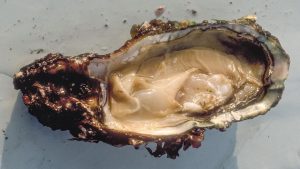
“So when you eat clams and oysters, you’re eating plastics as well,” Dudas says.
Funded by the Canadian government and British Columbia’s shellfish trade association, the project aimed to learn whether the shellfish aquaculture industry may be contaminating its own crop by using plastic infrastructure like nets, buoys and ropes. The experiment was a response to those claims by local environmental groups.
But tracking the origins of tiny plastic particles in a big ocean is new territory. So Dudas turned to Peter Ross, who has studied the effects of ocean pollution on sea life for 30 years.
“We’ve long known that plastic and debris can be a problem for ocean life,” says Ross, director of the Vancouver Aquarium’s Ocean Pollution Research Program.
In 2013, he began sampling the coast of British Columbia for microplastics. The researchers found up to 9,200 particles of microplastic per cubic meter of seawater — about the equivalent of emptying a salt shaker into a large moving box.
“So, large numbers,” Ross says. “Rather shocking numbers.”
The rest of the story can be found here.
Martin Patience of BBC News reports Nigeria has confiscated 2.5 tonnes of “plastic rice” smuggled into the country by unscrupulous businessmen, the customs service says.
 Lagos customs chief Haruna Mamudu said the fake rice was intended to be sold in markets during the festive season.
Lagos customs chief Haruna Mamudu said the fake rice was intended to be sold in markets during the festive season.
He said the rice was very sticky after it was boiled and “only God knows what would have happened” if people ate it.
It is not clear where the seized sacks came from but rice made from plastic pellets was found in China last year.
Rice is the most popular staple food in Nigeria.
The BBC’s Peter Okwoche says it is the only foodstuff that crosses cultural and ethnic lines across the country.
Whoever made this fake rice did an exceptionally good job – on first impression it would have fooled me. When I ran the grains through my fingers nothing felt out of the ordinary.
But when I smelt a handful of the “rice” there was a faint chemical odour. Customs officials say when they cooked up the rice it was too sticky – and it was then abundantly clear this was no ordinary batch.
They’ve sent a sample to the laboratories to determine exactly what the “rice” is made of.
They are also warning the public not to consume the mystery foodstuff as it could be dangerous.
Fake food scandals are thankfully rare in Nigeria when you compare it to countries such as China.
The big scandal here is fake pharmaceutical drugs that kill a huge number of people every year.
A total of 102 sacks, each containing 25kg (55lb), was seized.
Mr Mamudu did not explain how the plastic rice was made but said it had been branded as “Best Tomato Rice.”
I report on recalls every day, and usually don’t think much about it unless people are barfing.
 This morning, Unilever recalled 1.25 and two-litre Blue Ribbon ice cream tubs sold across Australia due to cases of plastic pieces causing injury risks.
This morning, Unilever recalled 1.25 and two-litre Blue Ribbon ice cream tubs sold across Australia due to cases of plastic pieces causing injury risks.
I thought, maybe that’s what’s in the freezer?
Affected products have a best before date between April 28, 2017 and April 27, 2018 and shouldn’t be eaten, the company said in a statement on Wednesday night.
According to reports the plastic pieces found their way into the ice cream via machinery during the production process at Unilever’s Minto factory where Blue Ribbon products are made.
The recall is a “precautionary measure” and tubs with a best before date from April 28, 2018 are not affected, the statement said.
Products can be returned to the place of purchase for a full refund.
 I got the ice cream out of the freezer.
I got the ice cream out of the freezer.
I put on my reading glasses.
I couldn’t see a damn thing.
Amy had a look and finally found the date, and we eventually made it out to say, best before March 21, 2018 (right, exactly as shown).
So I wandered off to the local Coles supermarket, and they refunded my $4.90.
I wandered over to the ice cream isle, and the Blue Ribbon was gone (left, exactly as shown).
Well done.
There’s not a lot of blue food.
That’s why the color blue is often used on plastic and packaging in food facilities.
Food manufacturers perform technological wizadry in screening everything from produce to poultry for physical hazards.
Foster Poultry Farms, a Farmerville, La. establishment, is recalling approximately 220,450 pounds of fully cooked frozen chicken nuggets that may be contaminated with extraneous blue plastic and black rubber materials, the U.S. Department of Agriculture’s Food Safety and Inspection Service (FSIS) has announced.
The fully cooked frozen chicken breast nuggets were produced on Feb. 22, 2016 and March 8, 2016. The following products are subject to recall: [View Labels (PDF Only)]
5-lb. bags containing FOSTER FARMS “Breast Nuggets – Nugget Shaped Breaded Chicken Breast Patties with Rib Meat.” The bags exhibit best by dates of 2/21/17 and 3/8/17.
10-lb. bulk boxes containing FOSTER FARMS “Fully Cooked Breast Nuggets – Nugget Shaped Chicken Breast Patties with Rib Meat Fritters.” The boxes contain package code 6053 and 6068.
The products subject to recall bear establishment number “P-33901” inside the USDA mark of inspection. These items were shipped to distributors in Alaska, Arizona, California, Utah, and Washington state.
The problem was discovered after the company received several consumer complaints and immediately notified FSIS on April 29, 2016.
There have been no confirmed reports of adverse reactions due to consumption of these products. Anyone concerned about an injury or illness should contact a healthcare provider.
Consumers who have purchased these products are urged not to consume them. These products should be thrown away or returned to the place of purchase.
McDonald’s Japan is facing yet another food safety scandal after two customers found pieces of plastic in their Chicken McNuggets.
The first discovery, made on Saturday, spurred McDonald’s Japan to pull all 956,925 nuggets made by a Cargill unit in Thailand on the same day, in the same factory.
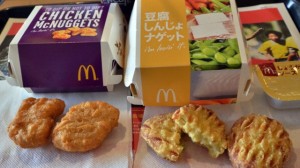 Despite the preventative action, another customer reported finding plastic inside a chicken nugget on Monday. McDonald’s is investigating, but has not yet said if the two incidents are related.
Despite the preventative action, another customer reported finding plastic inside a chicken nugget on Monday. McDonald’s is investigating, but has not yet said if the two incidents are related.
“We deeply apologize for the trouble we have caused our customers and we are taking quick measures to analyze the cause of the contamination,” said company spokesman Takashi Hasegasa.
The incidents are the latest in a string of food scares that have shaken Japanese consumer confidence in McDonald’s.
Among other incidents, a human tooth was found in a customer’s french fry in August, while a child in December cut his mouth on a piece of plastic that was in a chocolate sundae.
Last July, the company was among several fast food chains to be hit by a scandal involving tainted meat from a Chinese supplier.
Sales at McDonald’s Japan have dropped more than 10 percent every month compared to the same period last year since the food scare hit, even after the company switched to suppliers in Thailand. The company has said it expects to post a net loss for its current fiscal year — the first annual loss in 11 years — as a result.
Majid Ali, Muhammad Akram and Hamed Jabbar – who together own Star Takeaway in Oxford Road – pleaded guilty to four offences under the Food Safety Act 1990 and breaching Food Hygiene Regulations at Reading Magistrates Court on Thursday.
The court heard how, on September 4 last year, the takeaway sold a customer a 12” chicken and sweetcorn pizza with cling film embedded in it, which was then eated by the buyer’s two young children.
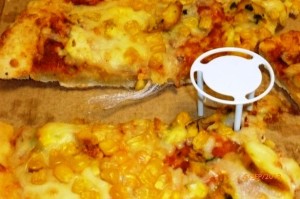 When the buyer complained to Reading’s Environmental Health department, council officers visited the restaurant and found that staff were untrained in food hygiene principles, that there was no food safety management system in place and that lettuce was at risk of contamination from defrosting raw chicken nearby.
When the buyer complained to Reading’s Environmental Health department, council officers visited the restaurant and found that staff were untrained in food hygiene principles, that there was no food safety management system in place and that lettuce was at risk of contamination from defrosting raw chicken nearby.
At the hearing, District Judge Davinder Larchar said: “Had the children choked to death on the cling film, you all could have been facing a more serious charge now at the Crown Court – murder or manslaughter.
“Health and safety practices are there for a reason: to protect the public. You started a new food business and have tried to do it on the cheap, without any training given to staff. You should have put all the procedures in place before opening for business.”

With the Marlies’ (Toronto’s most successful hockey team) season over, many Torontonians (they live in Canada) may turn their attention to the frothy battles between Mayor Rob Ford and his city council colleagues. At least until the Leafs start training camp.
Last week, in an attempt to repeal a rule requiring a 5-cent fee for to plastic bags at retail stores, Ford’s focus resulted in Toronto City Council banning plastic bags outright. Irony can be pretty ironic sometimes.
The fallout is following a particularly familiar path: a crusade on reusable bags in the name of public health.
Maryam Shah reports in the Toronto Sun:
With plastic bags soon to be outlawed in this city, possibly to be followed by other municipalities, many shoppers will turn to reusable bags as the logical replacement.
Maybe not.
University of Ottawa microbiologist Dr. Jason Tetro calls them "a nightmare for public health (units)," warning that people should be aware of bacteria growing on their bags.
"if you are getting groceries, then there’s a chance that they will end up leaking into the bag, and then you have growth and virus survival," he said.
He cited a report by the Canadian Plastics Industry Association (CPIA) from 2008, which said that reusable bags can harbour germs from meat and produce.
Nightmare might be a bit of an overstatement. The published evidence doesn’t even show that reusable bags are much of a risk factor.
The CPIA study the Germ Guy cites was based on data generated from swabbing a whopping 25 bags, with 4 controls looking for anything they could find.
Swab-testing of a scientifically-meaningful sample of both single-use and reusable grocery bags found unacceptably high levels of bacterial, yeast, mold and coliform counts in the reusable bags. The swab testing was conducted March 7-April 10th by two independent laboratories. The study found that 64% of the reusable bags were contaminated with some level of bacteria and close to 30% had elevated bacterial counts higher than the 500 CFU/mL considered safe for drinking water.
Um, yeah except that coliform isn’t an indicator of really anything in a shopping bag. It’s a great indicator of water quality, but not great for food (coliforms are all over the place, including on produce). The lack of real data is probably why it was reported in CFU/ml (a water measurement — pretty hard to tell what a ml of a shopping bag represents). The most telling data was that no generic E. coli or Salmonella was found.
Williams and colleagues (2011) have published the only peer-reviewed study on the microbial safety of reusable bags and tested growth of Salmonella in 2 batches. They spiked the bags with 10^6 cfu and let them sit in the trunk of a car for 2 hours. One of the batches, where the temperature reached 47C/117F, showed a one-log increase in the Salmonella. The other batch, where the temperature reached 53C/124F, there was a one-log reduction. That data doesn’t show just a breeding zone – it shows they can be a killing zone too (and I’m not sure how realistic a 10^6 contamination really is).
Friend of barfblog and food safety rock star, Sylvanus Thompson put things into perspective by saying there is currently no campaign targeting reusable bags and that Health Canada’s website provides safety tips for safely reusing grocery bags.
A bigger nightmare is the rumor the Leafs have interest in trading for Roberto Luongo.
Just cook it doesn’t cut it.
Especially when 10 per cent of 42 samples of packaging on chicken is contaminated with campylobacter on the outside.
(And another reason to wrap any poultry in extra plastic, especially if placing into a reusable bag.)
The Royal Environmental Health Institute of Scotland and other groups said the study confirmed the results of a previous survey by the group that also showed that approximately 10% of samples were 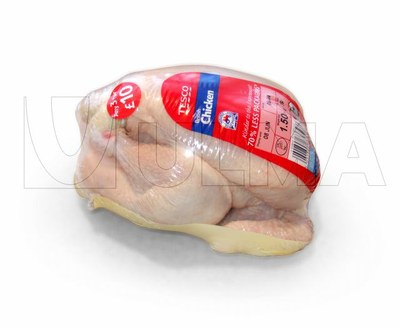 contaminated.
contaminated.
The Chairman of the West of Scotland Food Liaison Group (WOSFLG), Mr Leslie Paton said, “We know that it is fairly common to find Campylobacter in raw chicken but we were quite concerned about the extent to which the external surfaces of the packaging were also contaminated. There are implications for anyone handling such packaging and consumers should take care as there is a possibility of cross contamination to other surfaces and foods.”
Warning: avoid chunks of plastic when eating food from take-away containers.
Maybe that’s an additional warning required for those Styrofoam containers or clamshells, popular for leftovers and take-away food.
We developed safe handling labels for take-out food and showed those stickers can help restaurants and food providers distinguish themselves in a competitive marketplace. But now researchers report in the Medical Journal of Australia two separate cases where women accidentally swallowed a large chunk of plastic, 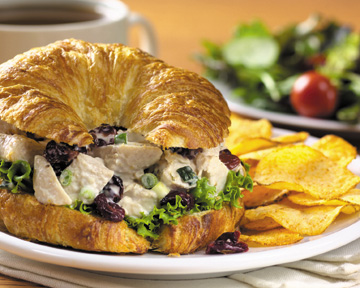 which became stuck in their throat and required a trip to hospital to have it removed, after eating food straight out of a take-away container, which had "softened" as a result of their meal being heated up in a microwave oven.
which became stuck in their throat and required a trip to hospital to have it removed, after eating food straight out of a take-away container, which had "softened" as a result of their meal being heated up in a microwave oven.
Dr Chris Pokorny from Sydney’s Liverpool Hospital, and colleagues, write,
"Given that take-away food containers are widely used, these cases highlight the need for care to be taken when heating food in such containers and then consuming directly from them."
The doctors warn the plastic softens during the heating process, and could be sliced through during the act of cutting up a bite-sized portion of food.
The paper also lists those items which most commonly get lodged in the throat, headed by a wad of improperly chewed food (17.1 per cent) then coins (15.6 per cent), fish bones (12.6 per cent), dental prostheses (8.6 per cent) and chicken bones (6 per cent).